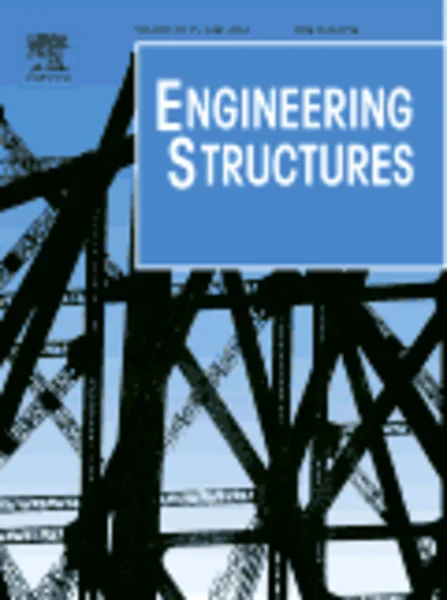-
variationally-based theories for buckling of partial composite beam–columns including shear and axial effects
جزئیات بیشتر مقاله- تاریخ ارائه: 1392/07/24
- تاریخ انتشار در تی پی بین: 1392/07/24
- تعداد بازدید: 851
- تعداد پرسش و پاسخ ها: 0
- شماره تماس دبیرخانه رویداد: -
this paper is focused on elastic stability problems of partial composite columns: the conditions for the axial load not to introduce any pre-bending effects in composite columns; the equivalence, similarities and differences between different sandwich and partial composite beam theories with and without the effect of shear, with and without the effect of axial extensibility, and also the effect of eccentric axial load application. the basic modelling of the composite beam–column uses the euler–bernoulli beam theory and a linear constitutive law for the slip. in the analysis of this reference model, a variational formulation is used in order to derive relevant boundary conditions. the specific loading associated with no pre-bending effects before buckling is geometrically characterized, leading to analytical buckling loads of the partial composite column. the equivalence between the hoff theory for sandwich beam–columns, the composite action theory for beam–columns with interlayer slip and the corresponding bickford–reddy theory, is shown from the stability point of view. special loading configurations including eccentric axial load applications and axial loading only on one of the sub-elements of the composite beam–column are investigated and the similarity of the behaviour to that of imperfect ordinary beam–columns is demonstrated. the effect of axial extensibility on kinematical relationships (according to the reissner theory), is analytically quantified and compared to the classical solution of the problem. finally, the effect of incorporating shear in the analysis of composite members using the timoshenko theory is evaluated. by using a variational formulation, the buckling behaviour of partial composite columns is analysed with respect to both the engesser and the haringx theory. a simplified uniform shear theory (assuming equal shear deformations in each sub-element) for the partial composite beam–column is first presented, and then a refined differential shear theory (assuming individual shear deformations in each sub-element) is evaluated. the paper concludes with a discussion on this shear effect, the differences between the shear theories presented and when the shear effect can be neglected.
مقالات جدیدترین رویدادها
-
استفاده از تحلیل اهمیت-عملکرد در ارائه الگوی مدیریت خلاقیت سازمانی و ارائه راهکار جهت بهبود
-
بررسی تاثیر ارزش وجوه نقد مازاد بر ساختار سرمایه شرکت های پذیرفته شده در بورس اوراق بهادار تهران
-
بررسی تأثیر سطح افشای ریسک بر قرارداد بدهی شرکت های پذیرفته شده در بورس اوراق بهادار تهران
-
بررسی تأثیر رتبه بندی اعتباری مبتنی بر مدل امتیاز بازار نوظهور بر نقد شوندگی سهام با تأکید بر خصوصی سازی شرکت ها
-
تأثیر آمیخته بازاریابی پوشاک ایرانی بر تصویر ذهنی مشتری پوشاک ایرانی (هاکوپیان)
-
پایش، مدیریت انرژی و نظارت هوشمندانه در صنعت ساختمان با بکارگیری ابزاری قدرتمند تحت فناوری rfid
-
ارزیابی اثر الیاف کامپوزیتی frp در تقویت پایه های بتنی دایره ای شکل پل ها به روش اجزا محدود
-
فراوانی آلرژن های پوستی در بیماران مبتلا به درماتیت تماسی
-
شیوع سل ریه در بیماران مبتلا به آنتراکو فیبروزیس – زاهدان
-
بررسی نقش فیبرینوژن در ارتباط احتمالی عفونت هلیکوباکترپیلوری با بیماری های ایسکمیک قلبی
مقالات جدیدترین ژورنال ها
-
مدیریت و بررسی افسردگی دانش آموزان دختر مقطع متوسطه دوم در دروان کرونا در شهرستان دزفول
-
مدیریت و بررسی خرد سیاسی در اندیشه ی فردوسی در ادب ایران
-
واکاوی و مدیریت توصیفی قلمدان(جاکلیدی)ضریح در موزه آستان قدس رضوی
-
بررسی تاثیر خلاقیت، دانش و انگیزه کارکنان بر پیشنهادات نوآورانه کارکنان ( مورد مطالعه: هتل های 3 و 4 ستاره استان کرمان)
-
بررسی تاثیر کیفیت سیستم های اطلاعاتی بر تصمیم گیری موفق در شرکتهای تولیدی استان اصفهان (مورد مطالعه: مدیران شرکتهای تولیدی استان اصفهان)
-
مقاوم سازی دیوار برشی فولادی
-
تاثیر روابط دیپلماسی دنیای اسلام و ایتالیا بر هنر استان توسکانی پیکره مطالعاتی: معماری رومانسک، نقاشی قرون وسطی
-
بررسی رابطه بین کیفیت سود و استرس مالی با توجه به نقش تعدیل گر دانش مالی اعضای هیات مدیره
-
study on seismic dynamic response of shallow-buried subway station structure and ancillary facilities
-
comparing semi active control of bridge via variable stiffness and damping systems and mr dampers




سوال خود را در مورد این مقاله مطرح نمایید :